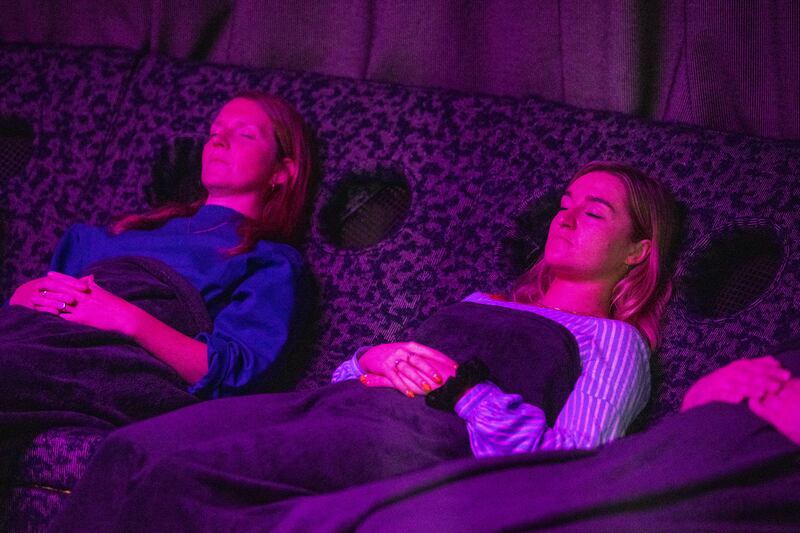Life can bring you to strange places. A few weeks ago I found myself in a decommissioned Scottish ice rink, preparing to submit to an allegedly hallucinogenic experience devised by an obscure post-war beatnik intellectual. All courtesy of a government-funded celebration of Brexit.
In 1961, Brion Gysin, a painter, poet and performance artist best known for the invention, along with his friend and fellow-experimentalist William S Burroughs, of the cut-up literary method, devised what he called the Dreamachine, described as “the first art object to be seen with the eyes closed”. The concept derived from Gysin’s transcendental experience on a bus to Marseille in 1958, when the flickering of sunlight through avenues of trees along the roadside put him into a hallucinatory, dream-like state. Gysin worked with Cambridge maths student Ian Sommerville to create a cylindrical device that he believed would replace every TV in every home and make us all creators of our own cinematic experiences.
Obviously that didn’t happen, but the contraption remains an intriguing relic of the ambitions of the post-war, pre-hippy avant-garde at a time when it was rebelling against the boundaries of rationality and seeking to remake the human psyche, sometimes but not always with the assistance of psychedelic drugs.

There were no drugs on offer at Murrayfield Ice Rink during the Edinburgh International Festival, but it felt as though there might as well have been, such was the number of forms to be filled, disclaimers to be signed and health and safety warnings to be listened to before we were permitted to enter the new Dreamachine, a circular structure in the centre of the rink (the ice, mercifully, had been removed). Our seats had speakers built into the headrests, and we were given blankets for our legs, along with eyemasks to put on if the experience proved too overpowering). The translucent ceiling above our heads would deliver the pulses of light, while the speakers would play a soundtrack by electronic composer Jon Hopkins.
READ MORE
The general vibe was mindfulness session meets chill-out zone. The revived Dreamachine, the work of art producer Jennifer Crook and architecture collective Assembly, seeks to emphasise the collective nature of the experience alongside the internal voyage of self-discovery that attracted Gysin. An important part of the project is gathering the reactions and impressions of the thousands of people who have visited it in Edinburgh, Belfast, Cardiff and London.
Anil Seth, professor of computational neuroscience at the University of Sussex, told the Guardian that the machine helps us address deep questions about the meaning of consciousness and the inner diversity of our mental lives. “We’re used to, as it were, external diversity – skin colour, different belief systems,” he said. “When people report what they have experienced in the Dreamachine, it shows us something that has obsessed me for years: internal diversity. Your experience of blue may be different from mine, but language suggests they are the same. In fact, maybe language works because it papers over these differences.”
It’s good, nevertheless, to see something genuinely thought-provoking finally come out of that benighted political process
For me, the experience was certainly intense. As powerful lights strobed across my eyelids, I saw a rapid sequence of shifting geometric shapes in bold primary colours. Relaxing further, I noticed my limbs were jerking slightly, like that involuntary spasm you get when you’re entering sleep and think you’re falling. None of this was unpleasant. It felt as if it had unlocked something in my brain of which I had previously only been dimly aware.
What was going on? Seth believes the geometric and kaleidoscopic images that people see “might be the visual cortex revealing its structure to us. These flickering light effects may be inducing us to see the cortex. It’s not by any means certain, but computational models suggest as much.”
There are ironies here. You can trace a line of descent from utopian precursors of the psychedelic counterculture like Gysin to the digital anarcho-libertarians of early Silicon Valley and on to the immersive, addictive, commodified environments purveyed by Meta, Alphabet and the rest. But Dreamachine, which is much closer in spirit and aesthetic to the transcendental, communitarian impulses of clubbing subcultures, is the anti-metaverse, the opposite of VR. Gysin, who wanted his invention to release us from being passive consumers of the mass-produced imagery of the late 1950s, would surely have recoiled from the far more media-saturated world we live in now, and found common cause with those who reject it.
Dreamachine has another week left to run in Edinburgh as part of Unboxed 2022, a programme of cultural and scientific projects initiated by Theresa May’s government in 2018 to “celebrate our nation’s diversity and talent”. It never quite recovered from its underlying rationale, made explicit by Jacob Rees-Mogg when he described it as the “Festival of Brexit”, It’s good, nevertheless, to see something genuinely thought-provoking finally come out of that benighted political process.
















